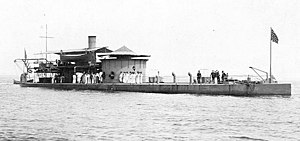USS Nahant (1862)
For other ships named Nahant, see USS Nahant.
The first USS Nahant was a Passaic-class ironclad monitor of the U.S. Navy that saw service in the U.S. Civil War and the Spanish-American War.
Nahant was launched October 7, 1862 by Harrison Loring, South Boston, Massachusetts and commissioned December 29, 1862, Commander John Downes in command.
The new single turreted monitor joined the South Atlantic Blockading Squadron at Port Royal Harbor, South Carolina on February 20, 1863 and saw her first action in the Union bombardment of Fort McAllister on March 3. A little over a month later, she participated in Rear Admiral Samuel Francis du Pont’s valiant but ill-fated attack on Charleston, South Carolina. The ironclads crossed Stono Bar and entered Charleston Harbor on April 6, but a heavy fog stopped their advance lest they run aground attempting to negotiate the tricky channels leading to the vital Confederate port. Though dawn broke clear the next morning, an ebb tide kept the warships from getting underway until noon. Shortly after 3 o’clock, USS Weehawken's guns opened on Fort Sumter, and through the afternoon Du Pont's ships stubbornly hammered at Confederate batteries while withstanding the intense and accurate converging fire of the Southern cannon.
With darkness approaching and his ironclads severely battered, Du Pont broke off the action, determined to return to the fray at daybreak. However, that night reports from his captains of the serious damage suffered by their ships convinced the Admiral that the small chance of success of another attack did not justify the great risk to his squadron.
In the fighting, Nahant had been hit 36 times disabling her turret and breaking off a large piece of iron inside her pilot house killing her helmsman and wounding her pilot. The next day with her sister monitors, she retired to Port Royal for repairs.
On 10 June, after intelligence reports indicated that CSS Atlanta was preparing to attack wooden blockader USS Cimarron, Du Pont ordered Weehawken, Captain John Rodgers, and Nahant to Wassaw Sound, Georgia to await the powerful ironclad ram. Shortly before dawn, a week later, Atlanta, accompanied by stern wheel gunboat CSS Isondiga and ram CSS Resolute, steamed down the Wassaw River and entered Wassaw Sound to attack the monitors. The Confederate flagship carried a torpedo projecting from her bow, hoping to explode it against one of the monitors before dispatching the other with her guns.
Seeing the Southern ships approach, Weehawken and Nahant headed in to accept the challenge. As the adversaries closed to fighting range, Atlanta was first to fire, but soon ran aground where she could not aim her guns effectively. The monitors held their fire until within 200 yards. Weehawken then quickly put five rounds from her heavy guns into the ram. With two of his guns out of action, two of his three pilots severly wounded, and his ship hard aground, Commander William A. Webb, CSN, was compelled to surrender Atlanta while her escorts scurried to safety. Atlanta was subsequently purchased from a prize court by the Federal Government and commissioned in the Union Navy.
Early in July, after he had taken command of the South Atlantic Blockading Squadron, Rear Admiral John A. Dahlgren ordered the monitors back to Charleston harbor. Nahant and her sisters bombarded Confederate works on Morris Island on July 10, supporting and covering the landing of Army troops. For almost two months, the shelling continued until the steadfast defenders were finally compelled to abandon Battery Wagner, their last position on the island, on September 6.
In ensuing months, Nahant continued operations in the vicinity of Charleston, patrolling, enforcing the blockade, and bombarding Confederate positions ashore. On November 15 she joined USS Lehigh in supporting the Union Army at Cumming’s Point on Morris during a heavy evening bombardment from Fort Moultrie. The next day, despite heavy shelling from shore batteries, she helped refloat Lehigh after her sister monitor had run aground.
On February 2, 1865, Nahant joined Lehigh and USS Passaic in shelling the Confederate blockade runner Presto after the blockade runner had run ashore under the batteries of Fort Moultrie. After three days of shelling, the hulk was completely destroyed.
Nahant decommissioned at Philadelphia, Pennsylvania on August 11, 1865. While laid up, she was renamed Atlas on June 15, 1869, but resumed the name Nahant on August 10. The veteran monitor recommissioned at League Island on April 12, 1898 and steamed to New York City for harbor defense during the Spanish-American War. Nahant decommissioned at League Island and was laid up there until sold on April 6, 1904 to L. E. Hunt of Melrose, Massachusetts.
Reference
![]() This article incorporates text from the public domain Dictionary of American Naval Fighting Ships.
This article incorporates text from the public domain Dictionary of American Naval Fighting Ships.

